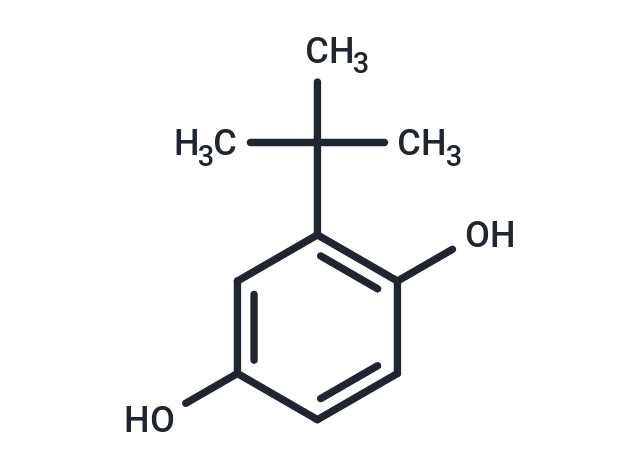Shopping Cart
- Remove All
 Your shopping cart is currently empty
Your shopping cart is currently empty

TBHQ (tert-Butylhydroquinone) is an antioxidant that induces an antioxidant response through the redox-sensitive transcription factor Nrf2.

| Pack Size | Price | Availability | Quantity |
|---|---|---|---|
| 500 mg | $41 | In Stock | |
| 1 g | $48 | In Stock | |
| 1 mL x 10 mM (in DMSO) | $45 | In Stock |
| Description | TBHQ (tert-Butylhydroquinone) is an antioxidant that induces an antioxidant response through the redox-sensitive transcription factor Nrf2. |
| In vitro | HeLa cells treated with tBHQ showed preferential oxidation of mitochondrial thioredoxin-2 (Trx2), while cellular glutathione and cytosolic thioredoxin-1 were not affected. With tBHQ treatments, Trx2 overexpression suppressed Nrf2 accumulation and activity [1]. Pretreatment of Jurkat T cells with tBHQ, prior to activation with anti-CD3/anti-CD28, diminished the production of interleukin-2 (IL-2) at both the transcript and protein levels. Similarly, the expression of CD25 also diminished, albeit to a lesser degree than IL-2, after pretreatment with tBHQ [2]. |
| In vivo | TBHQ treatment prevented left ventricular dilatation and cardiac dysfunction induced by TAC and decreased the prevalence of myocardial apoptosis. TBHQ-induced Akt activation was accompanied by increased phosphorylation of Bad, glycogen synthase kinase-3β (GSK-3β) and mammalian target of rapamycin (mTOR). Blockade of the Akt pathway in vivo accelerated cardiac dysfunction, and abrogated the protective effects of TBHQ. TBHQ also reduced the reactive aldehyde production and protein carbonylation in stressed myocardium [3]. |
| Cell Research | Jurkat T cells were cultured in 96-well plates (1×10^5 cells/well) and treated as described, and cell supernatants were harvested 24h after activation with anti-CD3/anti-CD28. IL-2 was quantified from cell supernatants by the use of a commercially available kit per the manufacturer's protocol. Relative light intensity was quantified at 450nm by Bio-Tek μQuant microplate reader. The IL-2 concentrations of each sample were then calculated using a line ar standard curve on Microsoft Excel [2]. |
| Animal Research | TBHQ powder was directly mixed with the animal food powder at a ratio of 1% (w/w) as described previously. The efficacy of this protocol for TBHQ treatment in vivo has also been validated by other groups. TBHQ treatment was continued for 4 weeks after the TAC surgery [3]. |
| Alias | tert-Butylhydroquinone |
| Molecular Weight | 166.22 |
| Formula | C10H14O2 |
| Cas No. | 1948-33-0 |
| Smiles | C(C)(C)(C)C1=C(O)C=CC(O)=C1 |
| Relative Density. | 295 g/cm3 |
| Storage | Powder: -20°C for 3 years | In solvent: -80°C for 1 year | Shipping with blue ice. | |||||||||||||||||||||||||||||||||||
| Solubility Information | DMSO: 50 mg/mL (300.81 mM) | |||||||||||||||||||||||||||||||||||
Solution Preparation Table | ||||||||||||||||||||||||||||||||||||
DMSO
| ||||||||||||||||||||||||||||||||||||

Copyright © 2015-2024 TargetMol Chemicals Inc. All Rights Reserved.